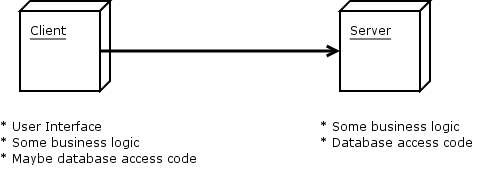分布式编程
http://cs.lmu.edu/~ray
Introduction to Distributed Programming
Definitions
- Distributed Computing
- Computing on a distributed system
- Distributed System
- A system of computers communicating via messages over a network so as to cooperate on a task or tasks. There's no physical shared memory in a distributed system, though algorithms can simulate such a thing.
Areas of Study
Here's five (of many, I'd guess):
- Networks and Internetworks
- Distributed Algorithms
- Paradigms
- Enterprise Computing
- Grid Computing
Networks and Internetworks
See this page.
Distributed Algorithms
Distributed algorithms are designed for programming distributed systems. They differ from centralized algorithms because they are unaware of any global state or a global time frame.
Issues:
- Modeling: transition systems, statecharts, temporal logic
- Communication, Timing, and Synchronization
- Routing Algorithms
- Virtual Circuits and Packet Switching
- Kinds of algorithms: wave algorithms, traversal algorithms, election algorithms, snapshot algorithms
- Distributed Termination Detection
- Distributed Deadlock Detection
- Distributed Failure Detection
- Stabilization
Distributed Computing Paradigms
- Client-server
- Multi-tier
- Peer-to-peer
- Publish/subscribe
- RPC
- Distributed Objects
- Object Spaces
- Mobile Agents
- Network Services
- Groupware
Enterprise Computing
Enterprise applications are applications that run on large servers with multiple (simultaneous) users communicating over a network via clients like web browsers, PDAs, cell phones, or desktop applications. These applications generally read from and write to big databases.
Some people say enterprise applications are only for business functions (accounting, customer management, product tracking, etc.); some say any big distributed application counts as "enterprise".
Enterprise Computing Platforms
There's legacy code out there — COBOL, IMS, CICS. But most current work is done in two:
- Java EE (also known as: Java Platform, Enterprise Edition)
- .NET (pronounced "dot net")
They didn't start off terribly different, and they're probably evolving toward each other. (Just like Java and C# are.)
| Java EE | .NET |
|---|---|
|
|
Enterprise Architectures
In the old days, and today for the most trivial of applications, we see client-server organizations.

Two tier architectures are almost always way too fragile. They soon gave way to three-tier architectures:

The idea here is that any one of the three layers can be completely re-implemented without affecting the others.
The middle layer completely isolates the front end from any knowledge of the database. The UI doesn't even know what the data source is. It just makes calls like fetchCustomerById(24337).
Software running in the middle tier is called middleware. Middleware products are also called containers, since they host and manage the business objects. They can manage lifecycles, transactions, memory, authentication, concurrency, distribution, security, sessions, resource pooling, logging and lots of other "system-level plumbing things" so developers only have to concentrate on business logic.
There's no need to stop at three tiers. You'll often hear the term n-tier.
Sometimes applications are classified by the complexity of the client:
| Thick Client | Thin Client |
|---|---|
|
|
Grid Computing
The term grid computing refers to the computation of highly compute-intensive algorithms (protein folding, SETI, earthquake simulation, climate modeling) over many computers across administrative domains. Most of the computers run similar code; they're all contributing bits toward the overall solution.



